2022 HYUNDAI SONATA HYBRID maintenance schedule
[x] Cancel search: maintenance schedulePage 471 of 527
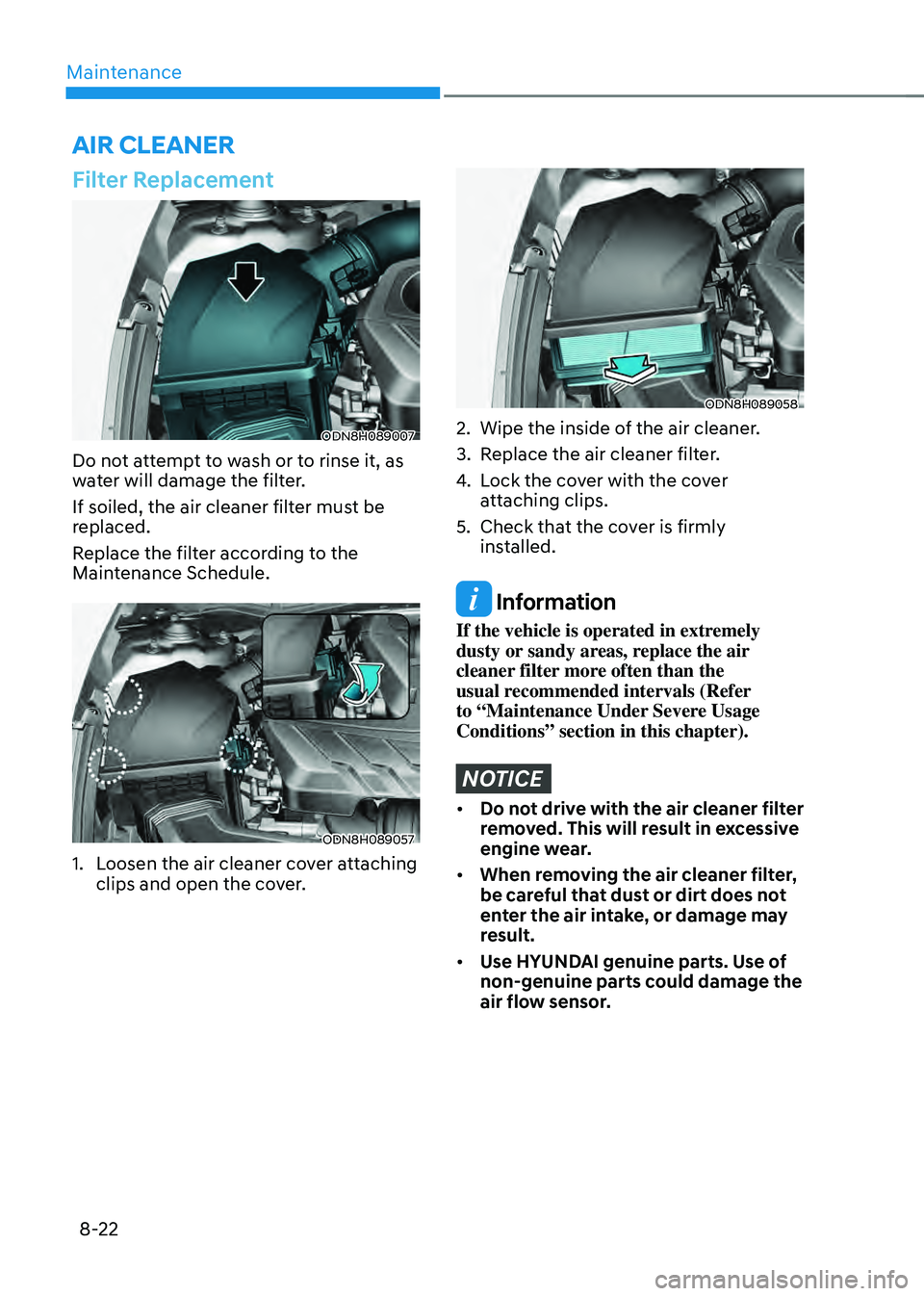
Maintenance
8-22
Filter Replacement
ODN8H089007
Do not attempt to wash or to rinse it, as
water will damage the filter.
If soiled, the air cleaner filter must be
replaced.
Replace the filter according to the
Maintenance Schedule.
ODN8H089057
1. Loosen the air cleaner cover attaching
clips and open the cover.
ODN8H089058
2. Wipe the inside of the air cleaner.
3. Replace the air cleaner filter.
4. Lock the cover with the cover
attaching clips.
5. Check that the cover is firmly
installed.
Information
If the vehicle is operated in extremely
dusty or sandy areas, replace the air
cleaner filter more often than the
usual recommended intervals (Refer
to “Maintenance Under Severe Usage
Conditions” section in this chapter).
NOTICE
• Do not drive with the air cleaner filter
removed. This will result in excessive
engine wear.
• When removing the air cleaner filter,
be careful that dust or dirt does not
enter the air intake, or damage may
result.
• Use HYUNDAI genuine parts. Use of
non-genuine parts could damage the
air flow sensor.
AIR CLEANER
Page 472 of 527
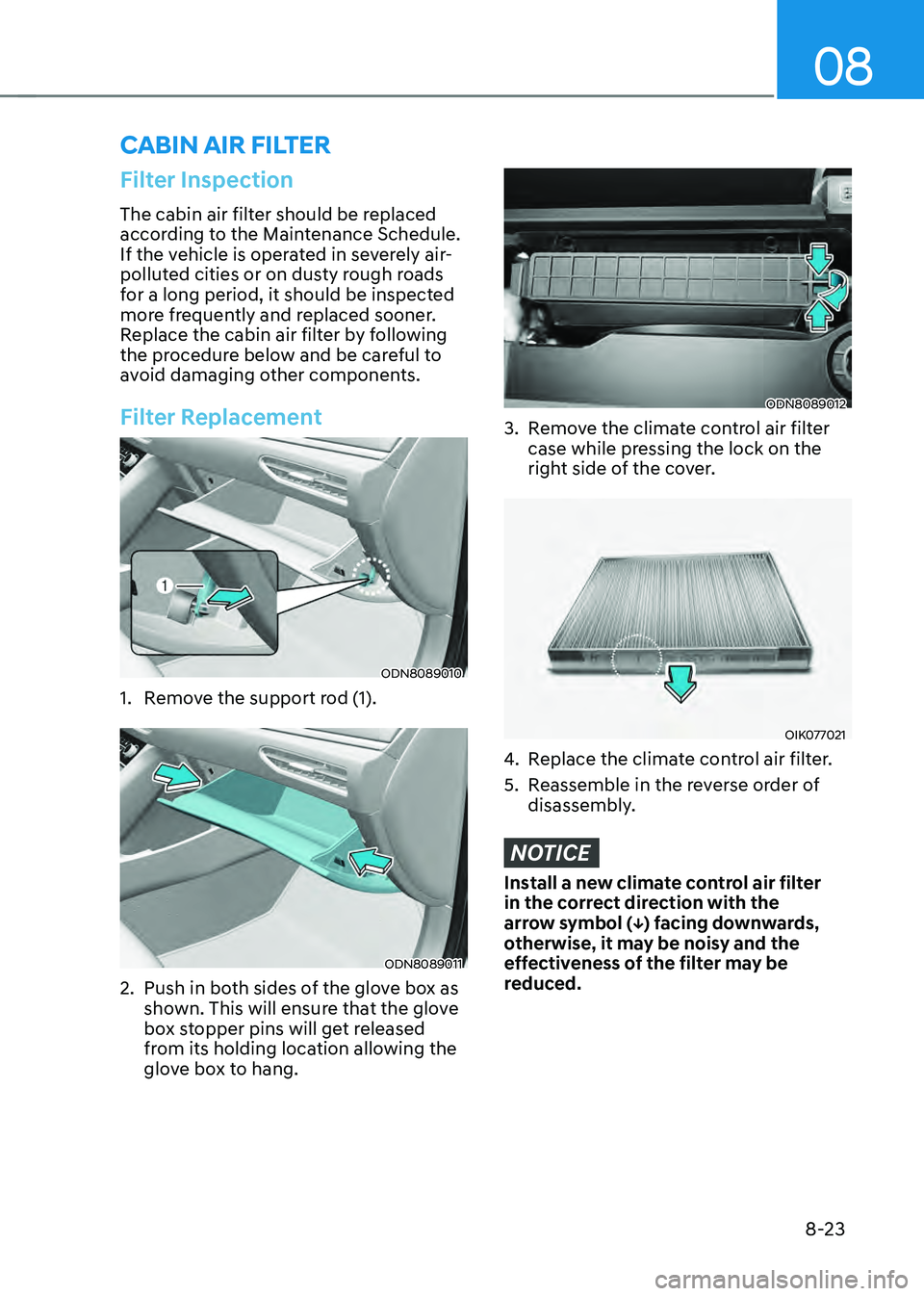
08
8-23
Filter Inspection
The cabin air filter should be replaced
according to the Maintenance Schedule.
If the vehicle is operated in severely air-
polluted cities or on dusty rough roads
for a long period, it should be inspected
more frequently and replaced sooner.
Replace the cabin air filter by following
the procedure below and be careful to
avoid damaging other components.
Filter Replacement
ODN8089010
1. Remove the support rod (1).
ODN8089011
2. Push in both sides of the glove box as
shown. This will ensure that the glove
box stopper pins will get released
from its holding location allowing the
glove box to hang.
ODN8089012
3. Remove the climate control air filter
case while pressing the lock on the
right side of the cover.
OIK077021
4. Replace the climate control air filter.
5. Reassemble in the reverse order of
disassembly.
NOTICE
Install a new climate control air filter
in the correct direction with the
arrow symbol (↓) facing downwards,
otherwise, it may be noisy and the
effectiveness of the filter may be
reduced.
CABIN AIR FILTER
Page 476 of 527
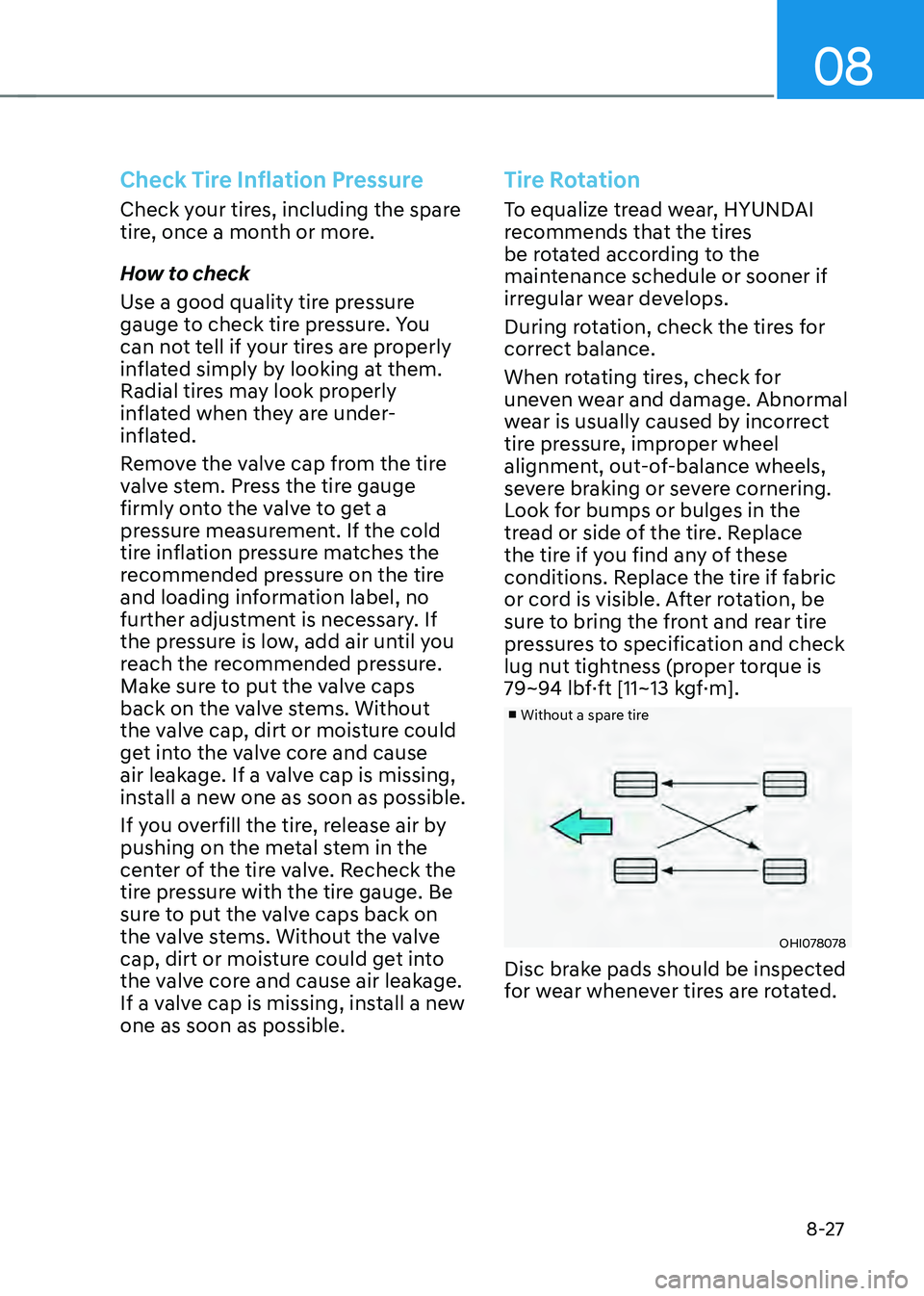
08
8-27
Check Tire Inflation Pressure
Check your tires, including the spare
tire, once a month or more.
How to check
Use a good quality tire pressure
gauge to check tire pressure. You
can not tell if your tires are properly
inflated simply by looking at them.
Radial tires may look properly
inflated when they are under-
inflated.
Remove the valve cap from the tire
valve stem. Press the tire gauge
firmly onto the valve to get a
pressure measurement. If the cold
tire inflation pressure matches the
recommended pressure on the tire
and loading information label, no
further adjustment is necessary. If
the pressure is low, add air until you
reach the recommended pressure.
Make sure to put the valve caps
back on the valve stems. Without
the valve cap, dirt or moisture could
get into the valve core and cause
air leakage. If a valve cap is missing,
install a new one as soon as possible.
If you overfill the tire, release air by
pushing on the metal stem in the
center of the tire valve. Recheck the
tire pressure with the tire gauge. Be
sure to put the valve caps back on
the valve stems. Without the valve
cap, dirt or moisture could get into
the valve core and cause air leakage.
If a valve cap is missing, install a new
one as soon as possible.
Tire Rotation
To equalize tread wear, HYUNDAI
recommends that the tires
be rotated according to the
maintenance schedule or sooner if
irregular wear develops.
During rotation, check the tires for
correct balance.
When rotating tires, check for
uneven wear and damage. Abnormal
wear is usually caused by incorrect
tire pressure, improper wheel
alignment, out-of-balance wheels,
severe braking or severe cornering.
Look for bumps or bulges in the
tread or side of the tire. Replace
the tire if you find any of these
conditions. Replace the tire if fabric
or cord is visible. After rotation, be
sure to bring the front and rear tire
pressures to specification and check
lug nut tightness (proper torque is
79~94 lbf·ft [11~13 kgf·m].
■ Without a spare tire
OHI078078
Disc brake pads should be inspected
for wear whenever tires are rotated.
Page 506 of 527
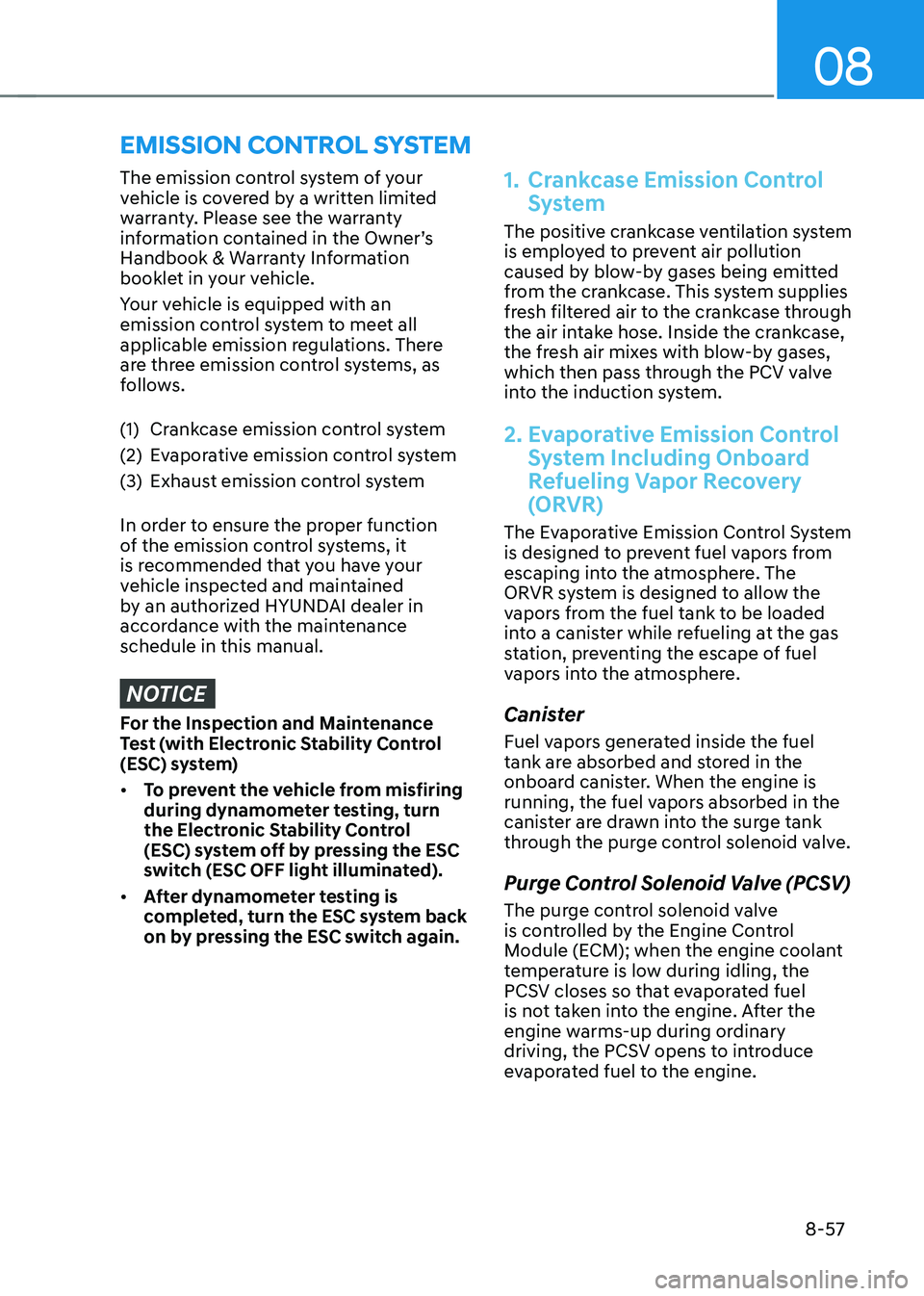
08
8-57
The emission control system of your
vehicle is covered by a written limited
warranty. Please see the warranty
information contained in the Owner’s
Handbook & Warranty Information
booklet in your vehicle.
Your vehicle is equipped with an
emission control system to meet all
applicable emission regulations. There
are three emission control systems, as
follows.
(1) Crankcase emission control system
(2) Evaporative emission control system
(3) Exhaust emission control system
In order to ensure the proper function
of the emission control systems, it
is recommended that you have your
vehicle inspected and maintained
by an authorized HYUNDAI dealer in
accordance with the maintenance
schedule in this manual.
NOTICE
For the Inspection and Maintenance
Test (with Electronic Stability Control
(ESC) system)
• To prevent the vehicle from misfiring
during dynamometer testing, turn
the Electronic Stability Control
(ESC) system off by pressing the ESC
switch (ESC OFF light illuminated).
• After dynamometer testing is
completed, turn the ESC system back
on by pressing the ESC switch again.
1. Crankcase Emission Control
System
The positive crankcase ventilation system
is employed to prevent air pollution
caused by blow-by gases being emitted
from the crankcase. This system supplies
fresh filtered air to the crankcase through
the air intake hose. Inside the crankcase,
the fresh air mixes with blow-by gases,
which then pass through the PCV valve
into the induction system.
2. Evaporative Emission Control
System Including Onboard
Refueling Vapor Recovery
(ORVR)
The Evaporative Emission Control System
is designed to prevent fuel vapors from
escaping into the atmosphere. The
ORVR system is designed to allow the
vapors from the fuel tank to be loaded
into a canister while refueling at the gas
station, preventing the escape of fuel
vapors into the atmosphere.
Canister
Fuel vapors generated inside the fuel
tank are absorbed and stored in the
onboard canister. When the engine is
running, the fuel vapors absorbed in the
canister are drawn into the surge tank
through the purge control solenoid valve.
Purge Control Solenoid Valve (PCSV)
The purge control solenoid valve
is controlled by the Engine Control
Module (ECM); when the engine coolant
temperature is low during idling, the
PCSV closes so that evaporated fuel
is not taken into the engine. After the
engine warms-up during ordinary
driving, the PCSV opens to introduce
evaporated fuel to the engine.
EMISSION CONTROL SYSTEM
Page 514 of 527
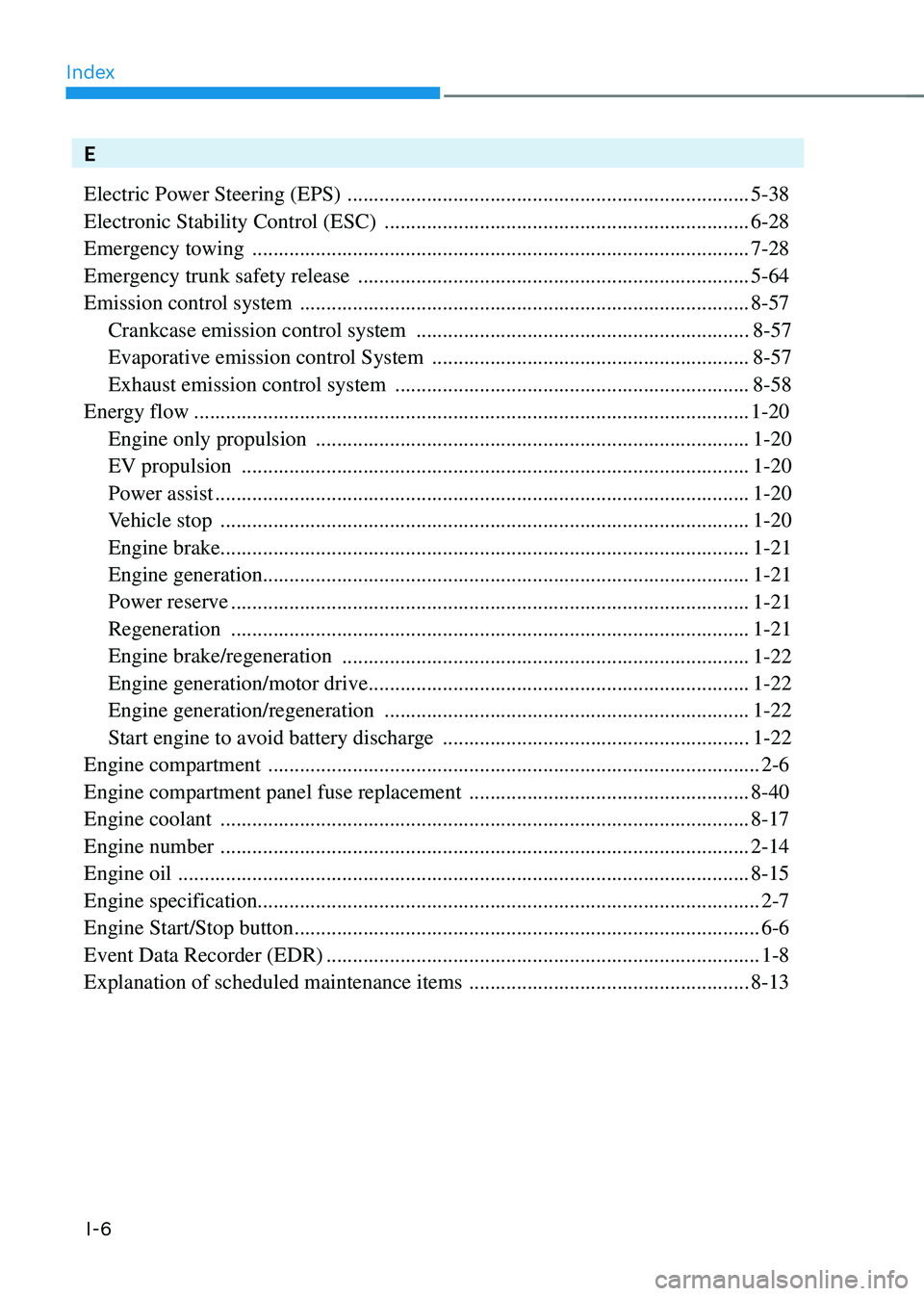
Index
I-6
E
Electric Power Steering (EPS)
........................................................................\
....5-38
Electronic Stability Control (ESC)
.....................................................................6-28
Emergency towing
........................................................................\
......................7-28
Emergency trunk safety release
........................................................................\
..5-64
Emission control system
........................................................................\
.............8-57
Crankcase emission control system
...............................................................8-57
Evaporative emission control System
............................................................8-57
Exhaust emission control system
...................................................................8-58
Energy flow
........................................................................\
.................................1-20
Engine only propulsion
........................................................................\
..........1-20
EV propulsion
........................................................................\
........................1-20
Power assist
........................................................................\
.............................1-20
Vehicle stop
........................................................................\
............................1-20
Engine brake ........................................................................\
............................ 1-21
Engine generation ........................................................................\
.................... 1-21
Power reserve
........................................................................\
..........................1-21
Regeneration
........................................................................\
..........................1-21
Engine brake/regeneration
........................................................................\
.....1-22
Engine generation/motor drive
........................................................................\
1-22
Engine generation/regeneration
.....................................................................1-22
Start engine to avoid battery discharge
..........................................................1-22
Engine compartment
........................................................................\
.....................2-6
Engine compartment panel fuse replacement
.....................................................8-40
Engine coolant
........................................................................\
............................8-17
Engine number
........................................................................\
............................2-14
Engine oil
........................................................................\
....................................8-15
Engine specification ........................................................................\
....................... 2-7
Engine Start/Stop button
........................................................................\
................6-6
Event Data Recorder (EDR)
........................................................................\
..........1-8
Explanation of scheduled maintenance items
.....................................................8-13
Page 521 of 527
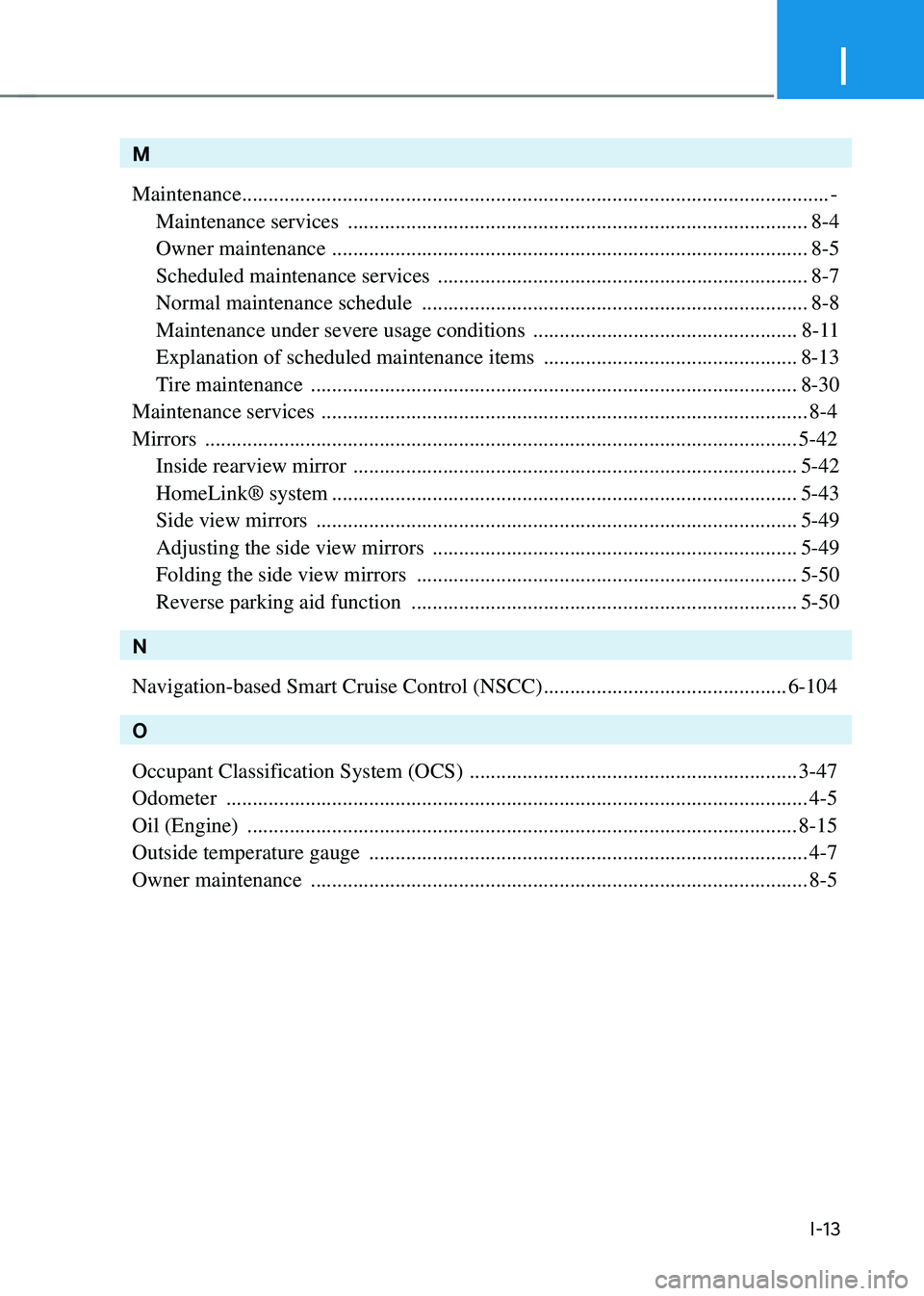
I
I-13
M
Maintenance
........................................................................\
.......................................-
Maintenance services
........................................................................\
...............8-4
Owner maintenance
........................................................................\
..................8-5
Scheduled maintenance services
......................................................................8-7
Normal maintenance schedule
........................................................................\
.8-8
Maintenance under severe usage conditions
..................................................8-11
Explanation of scheduled maintenance items
................................................8-13
Tire maintenance
........................................................................\
....................8-30
Maintenance services
........................................................................\
....................8-4
Mirrors
........................................................................\
........................................5-42
Inside rearview mirror
........................................................................\
............5-42
HomeLink® system
........................................................................\
................5-43
Side view mirrors
........................................................................\
...................5-49
Adjusting the side view mirrors
.....................................................................5-49
Folding the side view mirrors
........................................................................\
5-50
Reverse parking aid function
........................................................................\
.5-50
N
Navigation-based Smart Cruise Control (NSCC)
..............................................6-104
O
Occupant Classification System (OCS)
..............................................................3-47
Odometer
........................................................................\
......................................4-5
Oil (Engine)
........................................................................\
................................8-15
Outside temperature gauge
........................................................................\
...........4-7
Owner maintenance
........................................................................\
......................8-5
Page 523 of 527
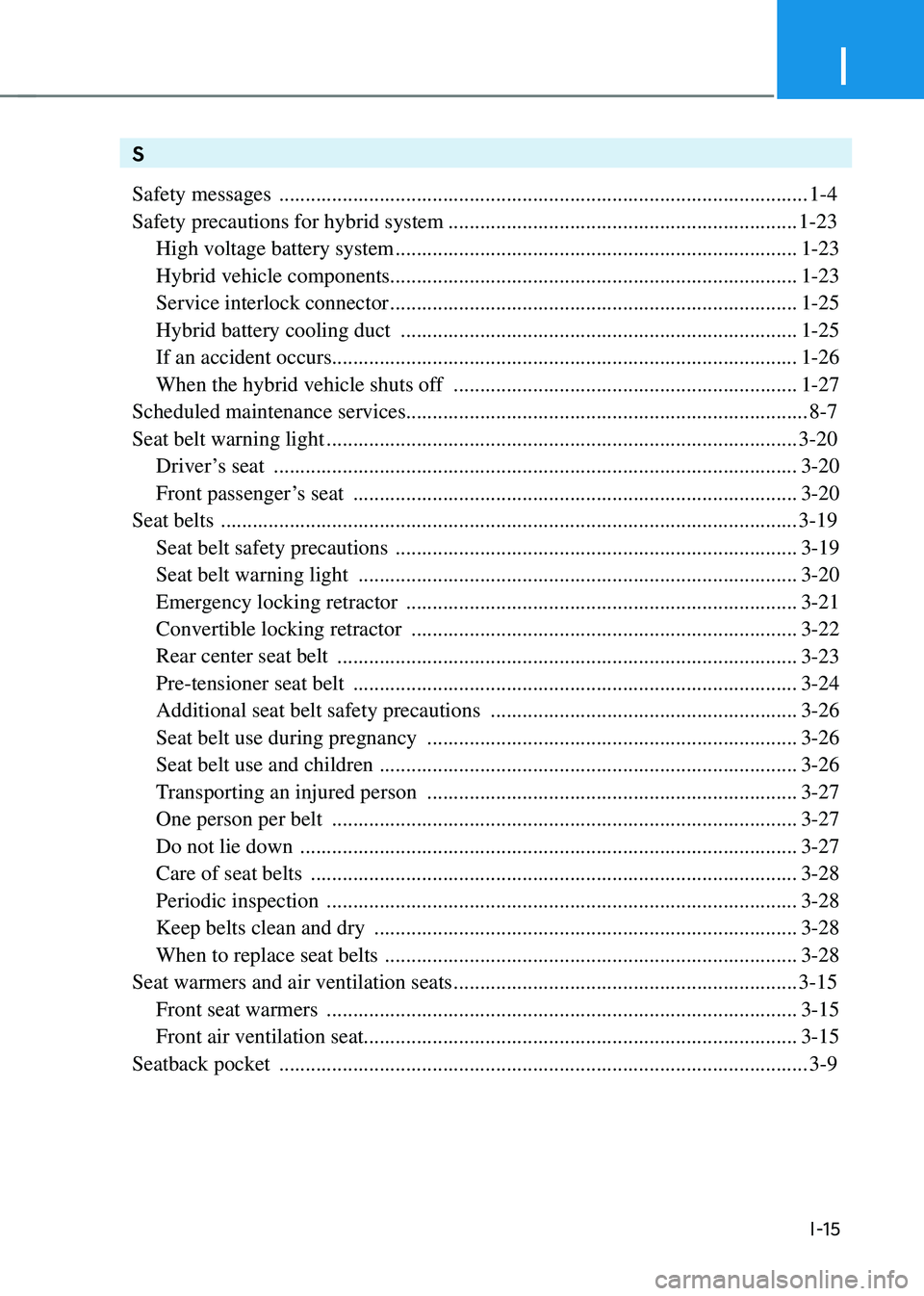
I
I-15
S
Safety messages
........................................................................\
............................1-4
Safety precautions for hybrid system
..................................................................1-23
High voltage battery system
........................................................................\
....1-23
Hybrid vehicle components ........................................................................\
..... 1-23
Service interlock connector
........................................................................\
.....1-25
Hybrid battery cooling duct
........................................................................\
...1-25
If an accident occurs ........................................................................\
................ 1-26
When the hybrid vehicle shuts off
.................................................................1-27
Scheduled maintenance services ........................................................................\
.... 8-7
Seat belt warning light
........................................................................\
.................3-20
Driver’s seat
........................................................................\
...........................3-20
Front passenger’s seat
........................................................................\
............3-20
Seat belts
........................................................................\
.....................................3-19
Seat belt safety precautions
........................................................................\
....3-19
Seat belt warning light
........................................................................\
...........3-20
Emergency locking retractor
........................................................................\
..3-21
Convertible locking retractor
........................................................................\
.3-22
Rear center seat belt
........................................................................\
...............3-23
Pre-tensioner seat belt
........................................................................\
............3-24
Additional seat belt safety precautions
..........................................................3-26
Seat belt use during pregnancy
......................................................................3-26
Seat belt use and children
........................................................................\
.......3-26
Transporting an injured person
......................................................................3-27
One person per belt
........................................................................\
................3-27
Do not lie down
........................................................................\
......................3-27
Care of seat belts
........................................................................\
....................3-28
Periodic inspection
........................................................................\
.................3-28
Keep belts clean and dry
........................................................................\
........3-28
When to replace seat belts
........................................................................\
......3-28
Seat warmers and air ventilation seats
.................................................................3-15
Front seat warmers
........................................................................\
.................3-15
Front air ventilation seat ........................................................................\
.......... 3-15
Seatback pocket
........................................................................\
............................3-9